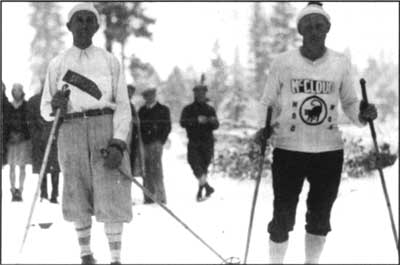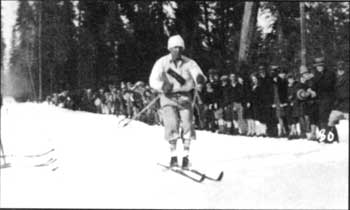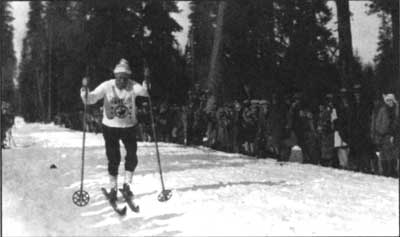The Long Forgotten Klamath Camp
By Kenneth Astrom
A remarkable silver trophy was displayed in the window of Monark’s Sporting Goods store on Kungsgatan Street at Umeå (Sweden), in 1961. It had been sent to Umeå by the Swedish Ski Association to be used as a challenge trophy in one of the Swedish Masters competitions. It was never awarded to anyone, as there was confusion as to the interpretation of the conditions set by the donor. As a result, the trophy lay forgotten until April 1964, when it was found in a display closet in Monark’s attic. The find started a debate when the news was published in the local press, and the question arose regarding how much control the association had on the trophy.
The trophy was returned to the association and put up as a prize for the Swedish skiing competition. It was decided that the trophy should go to the district which had garnered the highest point total in all the competition runs over the past five years. Lia Jonsson, at that time head administrator of the association, suggested that the trophy be donated to the Swedish Ski Museum as a challenge cup for the 30 km Umespelen competition, which was intended to be a future international fixture. This suggestion, however, was ignored.

Nordeen (left) and Jakobsson (right) before the 1931 race.
Photo courtesy Hartell family.
In January 1961, Emil Nordeen wrote to Lia Jonsson to make some things clear regarding the donation. “I could not see myself as sole owner of the trophy. For that reason I could not see anyone else as having sole possession.” When the Ski Association’s decision became known to Nordeen, he wrote to his sister Emmy:
“What happened at Umeå in 1961 has remained a mystery to me until I received your letter. When I came home from Squaw Valley I wrote an additional provision [in the donor agreement] that if there were terms at odds with the Swedish Ski Association’s rules, then it was the responsibility of the Association to work it out. It was my wish that the Americans would have a chance to win the trophy back, but this was not binding. When I read between the lines, I wonder if it is not the rules, but something else that is in the way, and which I, nor you, have any knowledge of. In any event, I now have nothing to say regarding the trophy since it is not my personal property…If they do not wish to enter it as a challenge prize, then I think they should give it to Vasterbotten where it should be housed. I wish the Swedish Ski Association could have followed my directions, but it is also a possibility that my Swedish is so poor that they didn’t understand what I wrote…”
Nordeen and the association eventually reached an agreement, which allowed for the trophy to be the prize for a long ski race in Vasterbotten. The choice was Kalvtrasket’s run, one of Sweden’s oldest cross country races, near the area where Nordeen was born. It was agreed that the trophy should be lodged at the Swedish Ski Museum at Umeå between contests.
Trophy from a ski race in Oregon
The background to events at Umeå in 1961 began with the Winter Olympics in Squaw Valley in 1960. During the Olympics Swedish-American Emil Nordeen from Kvavistrask, Norsjo, contacted the Swedish Ski Association and donated a majestic trophy to be used as a prize for an annual international men’s competition. One of the conditions stipulated by Nordeen was that the race must be international so that American skiers could participate.
 Nordeen near the finish. Photo courtesy Hartell family. |
Nordeen donated the Klamath Cup, which had been offered as a prize by the Crater Lake Ski Club beginning in 1929.1 It was the trophy recognizing the winner of a 70 km ski race between Fort Klamath and Crater Lake. The entire course was at high altitude, the first half of the race climbing close to 900 meters. In the event that anyone won the trophy twice, he would be allowed to keep it forever. The battle to be the first to win permanent possession of the trophy came down to two immigrants from Vasterbotten, Emil Nordeen and Manfred Jakobsson.2
Jakobsson was born at Högland, Nordmaling, in 1898. When he was seven years old, the family moved to Långed. Manfred worked in the timber industry at Norrbyskår until the winter of 1923, when he immigrated to southern California, where his sister already lived. After some time had passed, he went to McCloud in northern California, where he got a job in a lumber yard. His first experience with skiing competitions was in the early 1920s, when he won a ski race in Nordmaling.
Nordeen was born at Kvavistråsk in 1890. He had immigrated to America at age 18. For the next 20 years, his Swedish relatives received no word from him. When they finally made contact with him, Nordeen had spent much of his time in the Rocky Mountains. There he had hunted, fished, looked for gold, worked, and skied. In 1920 Nordeen settled in Bend, Oregon, where he found a job in a lumber mill.
The battle between Nordeen and Jakobsson
After four years in California without skiing, Jakobsson noticed a newspaper advertisement about a competition in Fort Klamath. With borrowed boots and nine foot skis that had poor bindings he traveled to Oregon, arriving about a week before the race. That year (1927) there was no trophy, but instead a prize of $250.00 to the winner, which at that time was worth about 1,200 Sw. kronor. The newspaper account of the race tells of the competition’s popularity, counting some 2,000 cars in Fort Klamath.3 Bets on the race were in the same style as in boxing, and included thousands of dollars. These were quite unthinkable circumstances in Swedish skiing at the time.
The first competition took place on President Washington’s birthday, February 22, 1927. Several thousand spectators came to watch Captain [O.C.] Applegate send off the poorly-equipped skiers. The first race took place under very difficult conditions. In Fort Klamath the grass protruded through the snow cover, and in some places there was water in the ski tracks. When the competitors got higher into the national park, there was heavy snow cover and a storm. In spite of this, Jakobsson won the race. Nordeen was among the other participants (who included a number of Swedes, Norwegians, and Finlanders) and had to make his own skis from ponderosa pine because none were for sale.
Jakobsson won again in 1928, but Nordeen was ahead for the first 55 km when ice built up under his new skis which he had ordered from Sweden. Nordeen won the Klamath Cup in 1929, the first year that the trophy was offered as a prize. Jakobsson, meanwhile, went home to buy a farm in Långed, where he eventually relocated when he returned to Sweden in 1932. During his visit in 1929, Jakobsson applied to race in the Vasa ski competition. His winning of the Fort Klamath competition and the $250.00 in prize money had been noticed in the Swedish press. Consequently, the Swedish Ski Association refused to let him compete at Vasa.

A weakened Jakobsson chasing Nordeen near the park’s south entrance.
Photo courtesy Hartell family.

